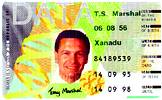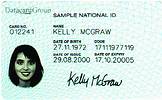

There is little doubt that the most basic reason for an identification card is to uniquely identify the cardholder. In this article we look at some of the some of the aspects to consider associated with the manufacturing and personalisation of secure identification cards.
The manufacture of secure ID cards could be achieved through numerous ways including:
* Standard photographic identification cards (cardholder's photograph, name and employee or ID number. Any number used on a card may for instance be complemented with barcodes.)
* Magnetic stripe cards with specific information written on the magnetic stripes.
* Smartcards with cardholder's information written on the chips (memory or microprocessor) embedded in the plastic that may have a variety of encryption and other security features.
* Any combination or permutation of the above.
Obviously the exact features to be incorporated on an identification card depends on a few criteria. It is important to define the specific function or usage of the card before any decision is made on the appearance of the card as well as the personalisation to be used on the card. Would someone benefit from producing a fraudulent card? What would the cost be to produce such an identification card? Should the cards be produced with pre-printed security features? How easy should it be to spot the authenticity of the card? There are a host of aspects to consider.
It is generally accepted that secure identification cards (documents) should be verifiable as original through complementary security features included for three levels of inspection:
* First line - Cursory examination without tools or aids involves easily identifiable visual or tactile features for rapid inspection at point of usage.
* Second line - Examination by trained inspectors with simple equipment (magnifying glass, UV light, machine reading equipment, etc).
* Third line - Inspection by forensic specialists conducting detailed examination allows for more in-depth evaluation and may require special equipment to provide true certification.
The different levels of security features currently available for a plastic card are discussed below. These security options all allow for security to be incorporated in both the manufacturing of the pre-printed card and at the point of issuance or personalisation.

First line inspection:
* Metallic and pearlescent inks - The typical appearance of metallic or pearl lustre inks cannot be mimicked by colour copiers or reproduced by scanning and reprinting. Although widely used for bank gold cards, the wide availability of these inks limits the security value of this feature.
* Optically variable inks - Optically variable inks (OVI) can be incorporated into designs to create a striking colour shift (for example, green to purple, gold to green, etc) depending on the angle of light used in viewing the card. This material consists of a transparent ink containing microscopic, advanced multilayer interference structures. OVI is precious, and production is available to secure printers only. Since the availability of these inks is highly restricted, true counterfeiting is unlikely. However, it is possible to create crude facsimiles that could be accepted by inexperienced examiners. For that reason, it is important to have reference standards available for training.
* Latent image - This feature is similar to the latent image used on may secure paper documents. A predetermined mixture of optically variable ink pigments is used to create this feature. The resultant image becomes more visible when the card is held at a certain angle. Images are uniquely created to apply to each required application.
* Rainbow printing - Sometimes called 'iris printing', this is a feature used only by selected manufacturers within the plastic card environment. Rainbow printing involves a very subtle shift in colour across the document. Widely preceived in Europe and Asia as an element of a secure document design, it is commonly used in conjunction with a fine line or medallion pattern in the background of the document. Well-designed patterns cannot be accurately reproduced on colour copiers or through the use of document scanners.
* Fine line background - Commonly called 'guilloche patterns', this detailing prevents accurate reproduction by copiers or standard document scanners, especially when used in conjunction with rainbow printing. A fine line background is constructed by using two or more intricately overlapping bands that repeat a lacy, weblike curve pattern on fine unbroken lines. Guilloche patterns are frequently printed on currency or valuable documents to raise a threshold against copying or the engraving of counterfeit plates.
* Irregular shape - This can be achieved through a specialised die cut, similar to many types of secure paper documents. The die cut must be isolated to the top of the document in order to be compatible with issuance equipment.
Optically variable devices:
* Holograms - The metallised reflective hologram has been a security feature for Visa and MasterCard cards for more than 10 years. The intrinsic security of the hologram results from a moveable image when viewed from different angles. It is not receptive to photography, photocopying, or scanning, and it requires highly specialised equipment to replicate designs. Counterfeit holograms that have been produced for credit cards are generally poorly made and do not provide true holographic effects. However, even poor facsimiles have often been sufficient to pass cursory inspection by an untrained inspector.
* Transparent holograms - It is also possible to incorporate holographic effects in a clear, transparent topcoat that can be applied over variable printing. Through careful design and physical registration, the clear holographic topcoat can serve as a deterrent to alteration in addition to its counterfeit protection features. If an attempt is made to remove or alter the topcoat, tampering will be detectable without the need of special equipment. Although it is possible to remove the holographic topcoat by mechanical or chemical means, once removed it cannot be recreated or replaced. Thin film holographic topcoats are currently used on many state drivers' licences as well as the new INS work permit card.
* Kinegrams - Kinegrams, like holograms, can be produced on a reflective or transparent material. However, unlike holograms, kinegrams only have two-dimensional effects, and effects are observable under a wider variety of lighting conditions. Also, kinegrams can incorporate asymmetric optical effects - that is, different optical variable effects are viewable as the kinegram is completely rotated (360°). Moreover, as a 'controlled product,' the kinegram is produced by only one company; the reflective hologram, on the other hand, is produced by numerous companies.
In the next issue of Hi-Tech Security Systems, we will continue with the discussion on first line security features in Part 2.
For further details contact Jannie van der Venter, Mr ID on tel: (011) 907 6912, fax: (011) 907 3566.
© Technews Publishing (Pty) Ltd. | All Rights Reserved.